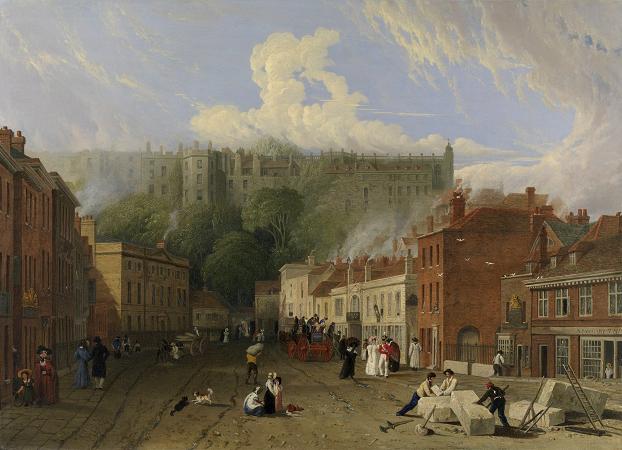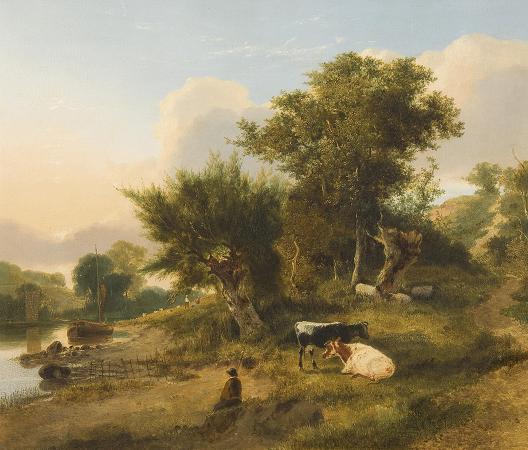George Vincent (c1796 - 1831). George Vincent was an English landscape artist. He is considered to be one of the most talented of the Norwich School of painters, a group of artists who all worked or lived in Norwich during all or part of their working lives from around 1800 to 1880. His work was founded on the style of John Crome, also of the Norwich School, and the Dutch School of landscape painting. The son of a weaver, Vincent was educated at Norwich Grammar School and afterwards apprenticed to Crome. From 1811 until 1831 he exhibited annually at the Norwich Society of Artists, showing more than one hundred pictures in all, mostly of Norfolk landscapes and marine works. He also exhibited at the Royal Academy, the British Institution, and elsewhere. By 1818 he had relocated to London, marrying the supposedly wealthy daughter of a surgeon in 1821. He was initially successful in obtaining the patronage of wealthy clients, but then began to struggle financially. The purchase of a grand house in London, combined with a tendency to drink, exacerbated his financial problems, and in 1824 he was incarcerated in the Fleet Prison for debt. Before his release in 1827 he had resumed his connection with the Norwich Society of Artists, albeit with a much declined output of work. After 1831, when he is known to have contributed to an art exhibition in Norwich, Vincent disappeared. He was never found, despite attempts by his family to locate him, and his whereabouts after this date remain uncertain. There is some evidence that he died before April 1832, perhaps in Bath. He was largely forgotten, until his picture Greenwich Hospital from the River, shown in an exhibition in London thirty years after his death, caused renewed interest in his paintings. The event helped to establish his reputation as a leading member of the Norwich School, along with the realisation that had George Vincent lived, he could have been one of Britain's great landscape painters. Further information: Norwich School of painters The Norwich School of painters, which included Vincent, was a group connected by geographical location, the depiction of Norwich and rural Norfolk, and by close personal and professional relationships. The school's most important artists were John Crome, Joseph Stannard, George Vincent, Robert Ladbrooke, James Stark, John Thirtle and John Sell Cotman, along with Cotman's sons Miles Edmund and John Joseph Cotman. The Norwich School was a unique phenomenon in the history of 19th-century British art. Norwich was the first English city outside London where a school of artists arose, and had more local-born artists than any subsequently-formed school elsewhere. Norwich's theatrical, artistic, philosophical and musical cultures were cross-fertilised in a way that was unique outside London. Within the Norwich School was the Norwich Society of Artists, which arose from the need for a group of Norwich artists to teach each other and their pupils. Though not all of the members of the Norwich School were also members of the Norwich Society, the latter was key in establishing the artists' associations with each other. The Society, in which Vincent would became a member, was founded in 1803. Its stated aims were to conduct an Enquiry into the Rise, Progress and Present State of Painting, Archaeology and Sculpture with a view to point out the Best Methods of Study to attain to Greater Perfection in these Arts. It held regular exhibitions and had an organised structure, showing works annually until 1825 and again from 1828 until it was dissolved in 1833. The leading spirits and finest artists of the movement were Crome and Cotman. The impact of the Norwich School outside East Anglia was based largely upon the works of Vincent and Stark, who were seen as important members of the second generation of the school, and whose exhibited paintings in the capital attracted much praise in the London press. Their connection with their home city was only occasionally noted, as the Norwich School was regarded at the time as being a provincial teaching centre. Interest in paintings by the Norwich School declined during the 1830s, but the school's reputation rose after the Royal Academy's 1878 Winter Exhibition. By the end of the century, however, its paintings, which had once been regarded as modern and progressive, were seen as belonging to a bygone age. This has been attributed by the Professor Andrew Hemingway to the mythology of rural Englishness that prevailed at the start of the 20th century. He has commented on a lack of analysis of the Norwich School, such as connections between the Norwich School painters and other artists and developments in landscape painting during the 19th century. Little is known of George Vincent's early childhood.
more...











